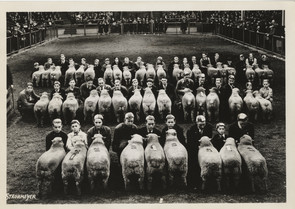
The Power of Agricultural Cooperative Extension: 100 Years of Penn State Service,” an exhibition, will be on display June 17 through Sept. 15, in The Special Collections Library, 104 Paterno Library, Penn State University Park. A special lecture, “The Impact of Cooperative Extension at Penn State,” is scheduled for noon to 1 p.m. Sept. 3 in Foster Auditorium, 102 Paterno Library.
In 1914, Congressman M. Hoke Smith (D-Georgia) and Asbury Lever (D-South Carolina) sponsored legislation to enhance the nation’s land-grant university system created under the Morrill Act in 1862. Signed into law on May 8, the Smith-Lever Act established the cooperative extension system. The system partnered federal, state and county governments with land-grant institutions, such as Penn State, to translate and share scientific information with farmers, and in communities across the country and the commonwealth.
Historically, Penn State had been providing lectures and publications at farmers’ institutes, at Farmers’ Week and through agricultural trains as far back as 1870. In 1892, it launched the nation’s first correspondence courses in agriculture and two years prior to the passage of the Smith-Lever Act, Penn State funded the first county agents in Blair, Butler, Mercer, Montgomery and Washington counties.
By 1921, 62 of the 67 Pennsylvania counties had full-time agents whose efforts were centralized through the College of Agriculture. The agents provided technical information, results from the experiment station, supervised experimental plantings, judged at local fairs, organized 4-H youth groups and provided various types of practical instruction through workshops, courses and institutes across the commonwealth.
The exhibit features archival materials documenting the revolution in practical advances spawned by the Smith-Lever Act and Agricultural Cooperative Extension, including demonstration methods, 4-H, early inventions and technology, home economics, trips and camps such as Club Week and Young Farmers Week, forestry improvements, nutrition and environmental progress. Access to actual archival documents from Cooperative Extensionagents is available.
The bulk of the archival collection contains county agent narrative and statistical annual reports of activities back to 1912, extension service publications, correspondence, photographs, land use surveys, youth programming, and financial records related to agricultural and home economics management. The reports are arranged alphabetically by county and within each county the reports are delineated chronologically.
Additional information about the Smith-Lever Act and the 100th anniversary of Agricultural Cooperative Extension is available.
For additional information about this exhibit, collections related to Agricultural Cooperative Extension and the University Archives or if you anticipate needing accessibility accommodations or have questions about the physical access provided, contact Jackie Esposito at 814-863-3791 or jxe2@psu.edu.